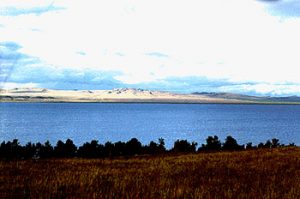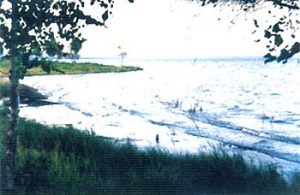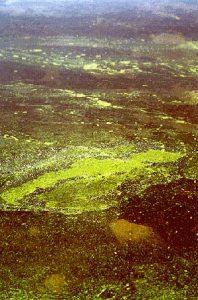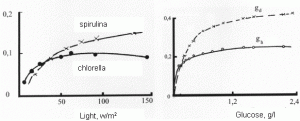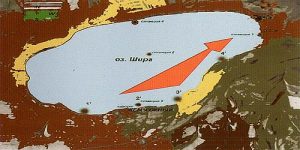Institute of Biophysics, SB RAS, Krasnoyarsk
Head of the Institute:
Andrey G.Degermendzhy, Doctor of Physical and Mathematics Sciences
Akademgorodok, Krasnoyarsk, 660036, Russia
Tel.: (3912)43-15-79,
Fax: (3912)43-34-00;
email: ibp@ibp.krasnoyarsk.su
Principal researchers:
A.G.Degermendzhy, Director of the Institute of Biophysics,
Doctor of Physical and Mathematics Sciences
Project objectives
The main objective of the work is to study actual mechanisms of matter turnover in the aquatic ecosystem of salt lakes (Lake Shira, Southern Siberia) with a naturally scanty species composition as a possible model (“natural laboratory”) for many ecosystems.
Objectives: 1) to assess the current ecological conditions of Lake Shira, including evaluation of hydrobiological, hydrochemical and hydrological conditions of the lake and its medicinal status; 2) to develop a system of monitoring the condition of the lake; 3) to develop a computer system for forecasting the condition of the lake on the basis of the structural-functional layout of the ecosystem and turnover of substances (sulphur, in particular); 4) to study mechanisms of algal “blooming”; 5) to study the plasmid profile of microflora of the lake and the effect of anthropogenic factors on the propagation of antibiotic-resistant plasmids in the microbial component and biodegradation of surfactants; to evaluate the feasibility of the propagation of genetically modified microorganisms and recombinant DNA in the natural microbial component of Lake Shira; to study the function of recombinant microorganisms in matter turnover processes; 6) to model mathematically and computer simulate consequences of different scenarios to analyse and develop recommendations on water management regime of the lake: a) changes in the runoff and contamination of the inflowing river; b) intensified activity of waste treatment facilities; c) complete elimination of runoff from the resort and settlement; d) changes in the discharge of fresh water from Lake Itkul into Lake Shira (limited horticulture).
Background and significance of objectives
Mineral water bodies are among the natural objects of high ecological and recreational value for the Republic of Khakassia. Among more than 110 permanent natural mineral lakes with the water surface area more than 10 ha, 12 lakes have water surface area more than 1 square kilometre – Bele, Shira, Vlasyevo, Uchum, Tagarskoye, Ulukh-Kol, Chernoye, Gorkoye, Altaiskoye, Terskoye, Tus and Utichye 1-3 lakes. The most famous is Lake Shira with a well-known Siberian spa.
All mineral lakes of Khakassia constitute a powerful recreational potential of Siberia that holds great promise and is yet to be developed.
Basic characteristics of the lake system (Lake Shira, Fig. 1): Distance from Abakan city ñ 120 km; from Krasnoyarsk ñ 360 km. Sunny days per summer ñ 46-52. Altitude above sea level ñ 354 m. Length ñ 9 km, width ñ 5 km. Water plane area ñ 34.7 sq. km. Average depth ñ 11.2 m, maximum depth (1986) ñ 21.7 m. Mineral water volume ñ more than 215 million cubic m. Average long-term runoff into the lake ñ 21 million cubic m/year. Anthropogenic runoff (in addition to the natural) ñ 1.6 million cubic m/year. Underground water exchange (% of total water supply) ñ 9%. Water formula: alkalescent, sulphate-chloride-sodium-potassium. Total amount of salts ñ more than 9 million tons; mineralisation (1998) ñ 19 g/l. Depth of occurrence of mud ñ 9 m. Layer thickness ñ 1.5 m. Mud stock ñ 18 million cubic m. Mud area ñ 19.7 sq. km. Composition: silicates and carbonates of Ca, Mg, Fe; oxides of Al, Ca. Organic matter ñ 4%. It is not inconceivable that unique healing properties of Shira lake, mainly determined by the specific chemical composition of salts, can be disrupted by the increasing anthropogenic impact: an increasing number of holiday-makers in cars and non-official holiday-makers, the observed intensive development of algae (“blooming”, Fig. 2).
In addition to applied problems, there are basic scientific problems. To resolve these problems is important both for scientifically based monitoring and control of the condition of the curable lake and for ecology on the whole:
-
In the number of species and number of trophic levels the system is rather poor and reduced. This makes it resemble laboratory systems. The literature available (from 1771 to date) has no evidence of ichtyofauna.
-
Perennial changes of the mineral composition and general mineralisation of the lake water is one of most important scientific issues. There is hydrological evidence that the course of changes in mineralisation and level of the lake are in antiphase, i.e. the total amount of dissolved salts is constant (about 9 million tons) and, consequently, the total concentration of salts is determined by the “input-output” ratio of fresh water budget (ultimately ñ by the volume of the lake). In this case the percentage of dissolved salts should be constant.
-
Among the most important scientific issues is the problem of high antimicrobial properties of Shira water and its causes, to say nothing of its salinity.
-
Algal “blooming” found in Lake Shira is not typical of mineralised water bodies. The literature on Lake Shira has no evidence of it, at least. The problem of the mechanism of development of “blooming” still remains to be solved.
The Institute of Biophysics has gained more than twenty year experience in the laboratory and field-laboratory cultivation of algae and other hydrobionts (fig. 3); the Institute has detailed knowledge about mechanisms of controlling the species structure of aquatic communities and methods of integrating experimental kinetic data with prognostication models of aqueous ecosystems. Dominant groups of aboriginal microflora of Lake Shira resistant to osmotic shock have been isolated. Functions of plasmid genes have been demonstrated to be associated with the natural habitat of microorganisms in the salt medium of Lake Shira lake and its gradient (Fig. 4). The Institute has developed a unique set of equipment for remote sensing and charting algal chlorophyll over water surface, bioluminescence-based express sensors for water toxicity and other up-to-date methods of ecological biophysics. The Laboratory of Analytical Chemistry, which is part of the Institute, has been certified by the state authorities (1993). To implement the proposed project, the Institute of Biophysics together with the Krasnoyarsk Institute of Geology and Mineral Resources (Roscomnedr) established in 1994 a field scientific laboratory on the shore of the lake.
The indicated scope of scientific and applied problems should be for the first time studied and solved by combined methods of ecological forecast modelling employing experimental kinetic and functional characteristics of Shira hydrobionts and observation data (including space-borne) on water condition.
Research plan: approaches and methods
Remote express monitoring, fluorescence, microbiological selective media, flow cultivation techniques, microcosm techniques, analytical chemistry and hydrochemistry, bioassays, mathematical modelling.
Expected results
Laws of formation and sustenance of steady matter turnover in non-flow highly mineralised water body with an ecosystem consisting of few species (Lake Shira) are to be studied; a system of monitoring water bodies analogous to Lake Shira is to be developed; computer database on Lake Shira is to be developed; an ecological certificate of Lake Shira is to be made; an efficient simulation system for quantitative forecast of the ecological condition and water quality for slow-flow water bodies is to be developed; the simulation forecast system is to be used to evaluate the efficiency of different water protection measures, to rank them by their ecological efficiency; a system of efficient measures for rational water management for Lake Shira and to preserve (and sustain) its unique healing properties is to be proposed.
List of publications of participants related to the project
-
Degermendzhy A.G., Gubanob V.G. et al. A Small Simulation System for Modelling the Carbon Cycle in the Krasnoyarsk Reservoir // Interaction of Biogeochemical Cycles in Aqueous Systems, Part 7 SCOPE/UNEP. ñ Hamburg: Univ. Hamburg, 1992. ñ P. 95-107 p.
-
Degermendzhy A.G., Adamovich V.V., Adamovich V.A. A New Experimental Approach to the Search for Chemical Density Factors in the Regulation of Monoculture Growth // Journal of General Microbiology. ñ 1993. ñ π 139. ñ P. 2027-2031.
-
Gubanov V.G, Degermendzhy A.G., Bayanova Yu.N. et al. Forecast Simulation of Ecosystem Dynamics and Water Quality Based on Kinetic Characteristics // Siberian G. Ecol. ñ 1996. ñ Vol. 3, π 5. ñ P. 453-472. (In Rus.).
-
Shevyrnogov A.P., Sukhinin A.I., Kashkin V.B., Sidko A.F., Vysotskaya G.S. “Green Wave” Research Program as a Means to Study Vegetation Dynamics in Krasnoyarsk Kray by Space-Borne Means // Siberian J. Ecol. ñ 1996. ñ Vol. 3, π 5. ñ P. 363-372. (In Rus.).
-
Kratasyuk V.A. Principle of Luciferase Biotesting // Proceeding of the First International School on Biological Luminescence, Wroclaw, Poland, June 20-23, 1989, World Scientific Publishing Co., 1990, Singapore. ñ P. 550-558.
-
Degermendzhy N.N., Zotina “.¿., Tolomeyev ¿.P. Structural-Functional Components of Plankton Community of Shira Lake Ecosystem Community (Survey and Experiments) // Siberian J. Ecol. ñ 1996. ñ Vol. 3, π 5. ñ P. 439-452. (In Rus.).
-
Brilkov A.V., Popova L.Yu., Baranova E.A., Maksimova E.A., Repeta T.V., Pechurkin N.S., A Forecast Study of Survival and Propagation of Gene-Modified Microorganisms in Laboratory Water Ecosystems // Proc. of the Acad. Sci. ñ 1995. ñ Vol. 341, π 3. ñ P. 429-430.
Fig. 1. Lake Shira.
Fig. 2. ìBloomingî on Lake Shira
Specific growth rates, 1/h.
Fig. 3. Experimental kinetic characteristics of blue-green microalgae
Fig.4. Gradient of multiple antobiotics tolerance decrease in microflora of Lake Shira (observations of 1996-1998).

